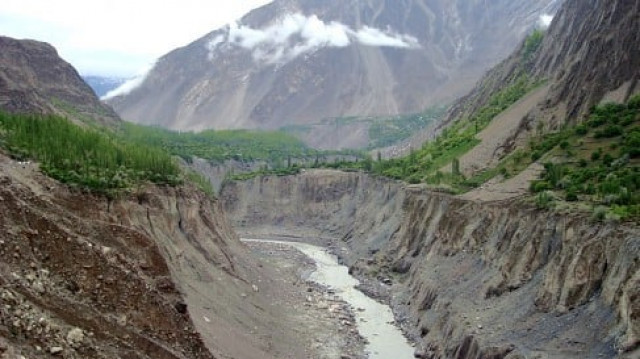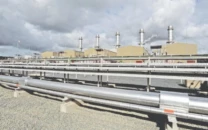Climate-driven erosion cuts Karakoram Highway in Upper Hunza
Accelerated glacial melt, rising temperatures key drivers of flooding, erosion

A significant stretch of the Karakoram Highway (KKH) in Upper Hunza’s Morkhun area was destroyed by river erosion on Friday, severing the overland link between Pakistan and China, the Gilgit-Baltistan (G-B) government said.
️ اہم اطلاع: پاکستان اور چین کے درمیان زمینی رابطہ منقطع ⚠️
— Gilgit Baltistan Tourism. (@GBTourism_) August 8, 2025
بالائی ہنزہ میں دریائے ہنزہ گلگت بلتستان کے شدید کٹاؤ کی وجہ سے شاہراہِ قراقرم (KKH) کا ایک حصہ گرچہ اور مورخون (زرت غار بین) کے مقام پر دریا برد ہو گیا ہے۔
اس کے نتیجے میں سوست اور ہنزہ کے درمیان شاہراہ ہر قسم کی… pic.twitter.com/VctQUGBg6b
"River erosion remains a key contributor to highway blockages in the region," a cryosphere expert told The Express Tribune. "Although disruptions on the KKH are not unusual, the current intensity of river swelling and the scale of damage are significantly higher."
G-B government spokesperson Faizullah Faraq confirmed that the increased river flow led to the erosion of a section of the KKH, rendering it impassable. Chief Minister Haji Gulbar Khan has directed immediate restoration of the highway.
Since June, Pakistan has faced severe flash floods driven by cloudbursts, glacial lake outburst floods (GLOFs), and heavy monsoon rains. G-B remains among the worst-affected areas due to its mountainous terrain and exposure to glacial melt.
This event also reflects a shift in snow cover dynamics across elevation zones in G-B. Snow cover area (SCA) has been decreasing at lower elevations, where key infrastructure, including highways, is often located, according to Winter report 2024-2025 by the National Disaster Management Authority (NDMA). The loss of seasonal snow at these elevations results in earlier and faster melt, causing rivers to swell more rapidly than before.
At the same time, permanent snow cover persists at higher elevations (above 5000 masl), where glaciated zones vary in size seasonally but show long-term shrinkage trends. In summer, the contraction of snowpack coincides with rainfall and GLOFs, multiplying hydrological stress on already fragile slopes and valley roads.
With the monsoon season ongoing and temperatures continuing to rise, officials have warned of more climate-related disruptions, urging residents and tourists to exercise caution and follow official advisories.
Data recorded between 2001 and 2020 shows that surface temperatures (LST) have risen steadily year by year, with sharp seasonal spikes in June, August, and September—precisely the months when monsoon intensity and glacial runoffs peak. These warming trends have led to the retreat of glaciers at lower elevations, adding to the volume of meltwater feeding into the region’s rivers. The increased runoff from snow and glacier melt in summer months exerts immense pressure on riverbanks, heightening the risk of flash floods and erosion events such as the one that severed the KKH.
Source: Winter report 2024-2025 by National Disaster Management Authority (NDMA)
Such hydrological changes result in severe erosion along riverbanks, compromising infrastructure and triggering landslides or washouts that obstruct vital transport routes like the KKH.
The rising frequency and severity of such incidents point to the increasing vulnerability of regional road networks to climate-induced hydrological shifts.
گلگت بلتستان میں گلیشئرز پگھلنے اور گرنے کا خوف ناک منظر۔❄️
— Gilgit Baltistan Tourism. (@GBTourism_) August 9, 2025
گلگت بلتستان میں قیامت خیز منظر
گلیشئر کا ٹوٹ کر گرجنا، پہاڑوں میں گونجتی دہاڑ، اور برف کے دیوہیکل تودے کا زمین پر گرتے ہی ہر طرف برفیلی دھول کا طوفان…! یہ کوئی فلم کا سین نہیں، بلکہ گلگت بلتستان کا حقیقت سے بھرا… pic.twitter.com/T08TgfyGbR
This calls for a combination of structural interventions and informed policy measures.
While snow cover shows a decreasing trend in spring and summer, it temporarily increases during winter at higher elevations. These opposing trends at similar altitudes increase the unpredictability of runoff patterns, making it more difficult to anticipate river behaviour. Combined with rising LST, these changes are likely to exacerbate the frequency of floods, landslides, and slope failures—threatening essential infrastructure like the KKH. Glacial retreat, especially at mid-range elevations of 3000–4000 masl, is expected to continue unless warming trends reverse, compounding the vulnerabilities for both natural and built environments.
"One key strategy is conducting detailed studies of river dynamics—including sediment transport, seasonal flows, and potential course changes—and performing risk assessments before road construction," said the cryosphere expert.
"Incorporating hydrological and geomorphological evaluations during the planning stages can reduce exposure to such risks."
"During winter, when river discharge is low, strategically redirecting river flow toward less populated, rugged areas may help reshape channels and reduce pressure on fragile banks. Gabion walls provide some defence against erosion, though their effectiveness decreases under high-intensity water flow."
However, such interventions must be carefully designed to avoid ecological or geomorphological harm.




















COMMENTS
Comments are moderated and generally will be posted if they are on-topic and not abusive.
For more information, please see our Comments FAQ